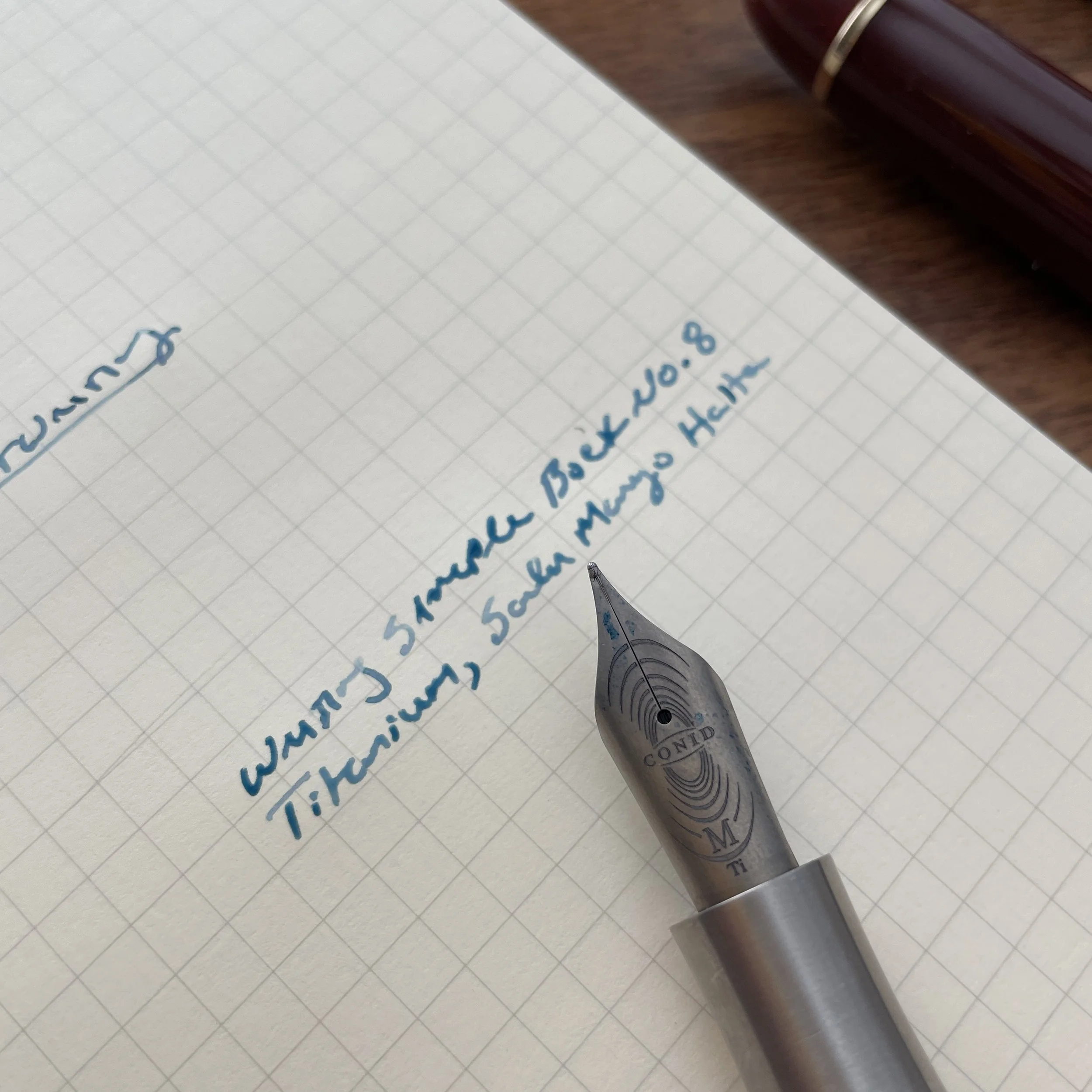Every year, there are a couple of products that see their popularity soar unexpectedly, despite the fact that the’ve been around for a while. In 2022 - and continuing into 2023 - one of those product categories is the No. 8 fountain pen nib. For those unfamiliar with fountain pen nib sizing schemes, the size of the nib itself (as opposed to the tipping) is denoted by number. Different regions (or even brands) will use their own numbering so there is little overall consistency, but for purposes of this article, the generally accepted “standard” nib size is a No. 6 (i.e., your typical JoWo or Bock nib), with the larger No. 8 rapidly growing in both popularity and availability.
If what you’re looking for is a bouncy, wet writer, a Bock No. 8 titanium nib, like the one on the Kingsize Bulkfiller, will serve you well. You also don’t need to pay Conid prices to get one. They are available separately from many different sources and can be fitted to pens like the Schon Ultem, provided you have the appropriate section. More on that below.
Why Do People Like No. 8 Nibs So Much?
A No. 8 nib just looks different. Part of the appeal is the uniqueness factor. The experience of writing with a nibbed pen adds much of the charm to using a fountain pen in general, and the larger No. 8 nib is especially eye-catching. The first time you see a pen like the Montblanc 149 or the Pelikan M1000, what you notice is that giant gold nib. Other companies, like Conid, offer gold but increasingly the standard No. 8 nib for small-batch and custom makers seems to be the less expensive No. 8 Bock titanium nib, with a matte finish that pops in its own way.
A smoother writing experience. Many people who first recommended No. 8 nibs to me commented on how much smoother they feel, and to a certain extent they’re correct. I suspect that the “smoother” feel comes from the larger feed, which if tuned properly will deliver more ink, which in turn makes the nib write “wetter,” and a wet nib typically feels smoother than a dry one because it masks any rough spots on the tipping or tine misalignment. If you like wet nibs with a bouncier feel, you will probably enjoy Bock No. 8 titanium nibs, which deliver a lot of ink and provide some line variation.
More stability and control. Personally, I appreciate No. 8 nibs for the same reason that larger pens are growing on me: a greater degree of stability and control over my writing. The larger nib feels more precise in your hand, especially with a finer nib like the one on the Jinhao X159 discussed below.
The pen on the left costs $1100. The pen on the right costs $12.50. As you can see, you don’t need to break the bank for the No. 8 writing experience.
Less Expensive No. 8 Nib Options Are Becoming More Widely Available
Currently, I have four No. 8 nibs in my collection: A Montblanc 149 with a broad nib (that writes more like a stub); a Montegrappa Extra 1930 with a medium nib; a Conid Kingsize Bulkfiller with a medium titanium nib (review forthcoming); and a Jinhao X159 that just arrived the other day. Of these four, the one that surprised me the most was the Jinhao. I love it when I discover extremely inexpensive pens that are fabulous writers, and while this stiff nail of a steel nib won’t give you the same wet writing experience or bouncy feel as the others discussed, for $12 I’m not sure you’re going to care. Because these larger Jinhao nib units are threaded and unscrew from the pen, I’ve heard that penmakers are starting to experiment with Jinhao-compatible sections, which will allow you to use these nibs in custom pens. Another less expensive option are the Magna Carta stainless steel nibs, which I’ve heard are compatible with the No. 8 sections made for the Schon DSGN Ultem pens. (UPDATE: See comments below, as people have had mixed success with Magna Carta. What I’ve heard is that the recent batch works with the Ultem pens, but YMMV.)
The Jinhao X159 writes a smooth, dark line. The writing experience offered by this pen punches FAR above its price point. The body of the pen does feel pretty inexpensive - even cheap (which it is), but the nib is superb.
Stay tuned for more No. 8 nib-specific content, specifically how these options all compare to one another. I’m planning on picking up some No. 8 sections for my Schon pens during this year’s pen show adventures, and I’m also looking forward to trying out the JoWo No. 8 nib, featured on the Edison Collier Grande.
Enjoy reading The Gentleman Stationer? We are supported entirely by purchases from the T.G.S. Curated Shop and pledges via the T.G.S. Patreon program. This post does not include paid advertising or third-party affiliate links.

